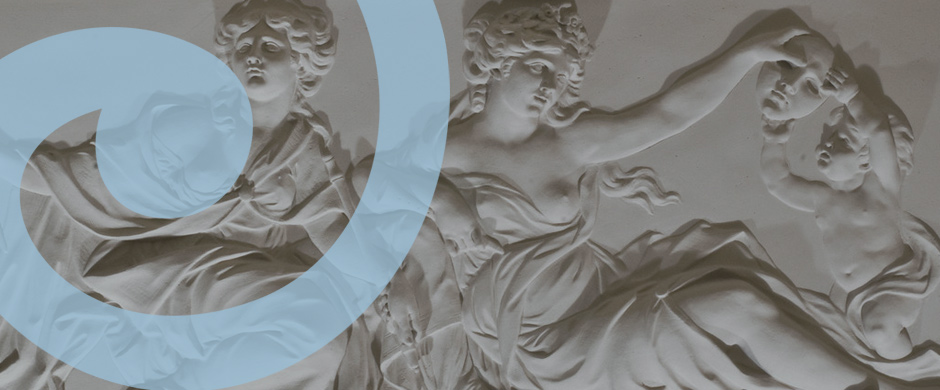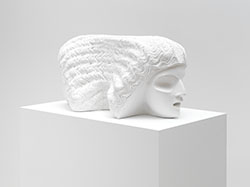 | ON DISPLAY
| ON DISPLAY

The Great Hall Exhibitions Archive
There are two Great Hall Exhibitions per year showcasing prominent contemporary artists. Taking place in the fall and spring semesters, the expansive great hall of the Duke House, a historic landmark building, provides an impressive setting for displaying seminal contemporary art in the center of the Institute’s academic home and community.
Fall 2019
Sarah Peters: Glossolalists
October, 2019 – February, 2020

Sarah Peters, Glossolalists, 2019 |
The Institute of Fine Arts at NYU is pleased to present its fall show, Glossolalists, featuring work by the New York-based artist Sarah Peters. The exhibition proudly continues a commitment to present the work of mid-career women artists at the Institute’s James B. Duke House. Peters’ figurative art emerges from her interest in the formal sculptural practices of distinct historical periods, from ancient to modern, resulting in a unique visual language. Set within the building’s Beaux-Arts interior, her sculptures resonate with the Great Hall’s marble floors, gilded wrought iron details, and Neoclassical statues.
Peters’ plaster busts draw inspiration from a variety of historical subjects and styles. During her formal education at the Pennsylvania Academy of the Fine Arts, the artist began drawing Greek and Roman plaster casts, as well as heroic-scaled allegorical figures by neo-classical American sculptor William Rush featured at the Academy museum. Enticed by the possibility of creating a visual lexicon that is rooted in classical and ancient archetypes, but given contemporary contexts, Peters’ unique approach was born.
The exhibition’s title, Glossolalists, is inspired by a work in the show. It refers to those who speak a language unknown to them during a trancelike state of religious ecstasy, also known as “speaking in tongues.” Peters’ art references Assyrian antiquities, Greco-Roman comedy and tragedy masks, Cypriot statuary, ships’ figureheads, and early twentieth-century sculpture. This cross-pollination pays tribute to the dominant influence of ancient traditions, while at the same time questioning them, allowing the artist to challenge the politics of cultural hierarchy and social conflict.
For Peters, the medium of sculpture maintains its roots in worship and functions as a means for connecting the viewer to its respected traditions. She creates complex, often disquieting sculptures with several trademark features, such as recessed, hollowed eyes that seem to fix the viewer with a cryptic stare, extreme or paradoxical forms of symmetry, and meticulous attention to hair. The sculpture Glossolalists represents worshippers, a common theme in ancient art; it also exemplifies Peters’ use of texture and pattern created by fine lines etched into her material’s surface. These lines undulate around the figures’ faces and provide an architectonic support that holds the busts aloft. Peters states, “In my work hair performs formal functions such as pattern, geometry, drawing, and architecture but it also enacts emotion and wildness tamed.” The shared coiffure of Glossolalists represents the collective taming of our feral natures, while its decorative precision evokes sound waves as if amplified from the twin gaping mouths that appear to be singing or crying out in exaltation.
Reminiscent of Greco Roman images and made without a model in partial resemblance to herself or family members, male and female busts alike address themes of power, sexuality, and gender, but also recall other artistic traditions. Peters’ Brutalist incorporates machine-like indentations and a space-age shape common in mid-twentieth century Brutalist architecture. The empty eye sockets and frozen expression of this portrait, along with its Roman styled hair and beard, create a sense of anonymity, male dictatorial authority and contemplative control simultaneously. Although her sculptures’ facial expressions are ambiguous, they are meant not only to convey religious and masculine oppression, but to express conflicting thoughts associated with the relationship between essence and existence. The unique characteristics inherent in these bodiless heads embody and address aspects of human nature, creating a dialogue between the past and present yielding a provocative uncanniness.
Sarah Peters (b. 1973, Boston, MA) lives and works in Queens, NY. She earned a BFA from the University of Pennsylvania, an MFA from Virginia Commonwealth University, and a certificate from the Pennsylvania Academy of the Fine Arts. Her work has been shown at the Aldrich Contemporary Art Museum, Ridgefield, CT; Atlanta Contemporary, Atlanta, GA; Frederik Meijer Gardens & Sculpture Park, Grand Rapids, MI; among others and most recently at Van Doren Waxter, New York, NY; Perrotin Gallery, Seoul, South Korea; and Eva Pressenhuber Gallery, New York, NY. She is the recipient of numerous awards and residencies, including a National Academy Affiliated Fellow at the American Academy in Rome this fall 2019.
This exhibition was made possible through the generous support of Valeria Napoleone XX and Van Doren Waxter. Special thanks to the artist and Van Doren Waxter for lending the works on view. The exhibition is curated by Makenzi Fricker, Scout Hutchinson, Deborah Miller, and Juan Gabriel Ramirez Bolivar.



